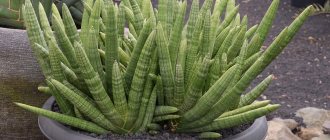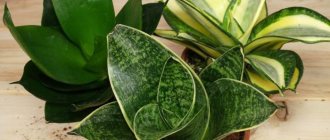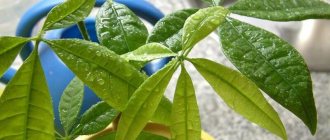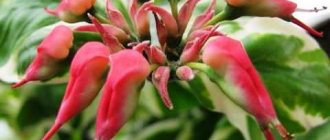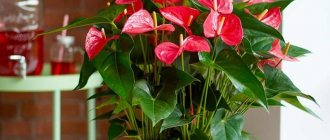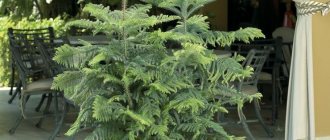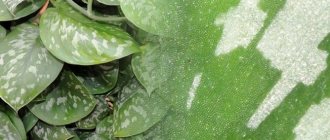Author: Elena N. https://floristics.info/ru/index.php?option=com_contact&view=contact&id=19 Category: Houseplants Published: February 21, 2019Last edits: January 11, 2021
- Rhizome division
- Sansevieria grandis
Not many gardeners know that Sansevieria loves to spend its summer holidays outdoors. But in vain! After all, for such a “vacation”, a plant with a bunch of the most formidable names will almost certainly thank you with a modest, but so vanilla-fragrant flowering! How to arrange everything? With the onset of stable spring warmth, a pot of sansevieria can be placed on a balcony or veranda, but it is even better to transplant the “tongue of Satan” into open ground. The main thing is not to forget to take the rested and strengthened sansevieria home in September. Interesting fact: at home, Sansevieria most often blooms when... its pot becomes too small for it! After enjoying the long-awaited flowering, do not forget to replant the flower. How to do this correctly, as well as about the nuances and possible problems in growing sansevieria, read in our article.
Planting and caring for sansevieria
- Flowering: decorative deciduous plant.
- Lighting: partial shade, bright diffused light.
- Temperature: normal for residential premises. In winter, not lower than 16˚C.
- Watering: regular, moderate, more frequent in summer than in winter.
- Humidity: normal for residential premises.
- Feeding: during the active growing season, once a month with a fertilizer solution for cacti or decorative foliage plants.
- Rest period: not clearly expressed.
- Repotting: when the pot becomes too small for the plant.
- Reproduction: vegetative (by rhizome division or leaf cuttings).
- Pests: mealybugs, thrips, spider mites.
- Diseases: anthracnose, root rot.
Read more about growing Sansevieria below.
Sansevieria , or sansevieria , or sansevieria , is a genus of the Asparagus family (in some catalogs - Agaveceae), which includes more than 60 species of evergreen perennial stemless plants from the rocky, dry regions of the tropics and subtropics of Africa, Madagascar, South Florida, Indonesia and India. This unpretentious and therefore popular indoor plant in different countries has received the nicknames “pike tail”, “snake skin”, “mother-in-law’s tongue”. Its value is that it is indestructible: you can forget about it for a week or two, and it will not die or dry out. In addition, the Sansevieria plant is happily used by designers to create flower arrangements and decorate interiors.
Step-by-step instructions for planting a flower
The roots of the flower grow not deeper, but wider, and sometimes, having freed the plant from the old pot, the owner is surprised to contemplate the huge root spiral with young shoots on it. In nature, the root, not limited by anything, grows as it pleases, and new shoots of sansevieria simply emerge from the ground along its entire length.
You will need:
- sharp knife;
- a new pot (or several, depending on how much the sansevieria has grown);
- drainage;
- soil for succulents or neutral for decorative foliage plants (you can find out what soil for sansevieria should be like here);
- a little crushed activated carbon.
Procedure:
- Run the blunt side of the knife inside along the edge of the pot to separate the earthen lump.
- Remove the sansevieria from the pot and carefully shake off the old soil from the roots. This can also be done in a bowl of water by rinsing the roots.
- If there are a lot of young plants, carefully cut the rhizome with a knife, leaving the growing points. Treat the cut areas with charcoal. It is advisable to separate the children from the mother plants. Leave it to dry for a day or put it in water, but both are not necessary for successful rooting.
- Pour expanded clay into the bottom of new pots according to the number of plants.
- Install a new sprout in each one and sprinkle it well with soil, compact it, water it and, if possible, strengthen it until the end of the plant’s adaptation period.
Help: you can plant one or several plants in one pot, but you must remember that each of them, having become independent after being separated from the common root, will start its own reproduction process.
Features of cultivation
Each plant has its own whims, and if you are going to grow this or that flower in the house, you need to familiarize yourself with its agricultural technology and decide whether it is suitable for you or not. Indoor Sansevieria is good because it requires very little attention, but at the same time it looks wonderful.
So, what is interesting about Sansevieria:
- It is enough to fertilize it once a year, but if you do it more often, it will certainly accept it with pleasure;
- the best place for sansevieria is a windowsill, since it needs as much natural light as possible, and it doesn’t really matter whether it’s warm or cold on the windowsill;
- and yet direct sunlight can cause burns to the plant, so place the sansevieria on the windowsill of the window into which the sun peeks in in the late afternoon;
- The worst thing for sansevieria is waterlogging of the soil, which causes it to die.
Pike tail (sansevieria): varieties
Varieties of Sansevieria differ significantly from each other in their appearance: leaf shape, color of stripes and size - from a giant cylinder to a small Hunny. In order not to get lost among such diversity, you should familiarize yourself with the most common of them.
Sansevieria three-striped, the same one that is called the “pike tail”, has dark green leaves lined with transverse light stripes. The height of the leaves reaches 120 cm, and their width is 10 cm. The green edges of the leaf, tapering towards the top, form a spike.
Sansevieria three-lane
Sansevieria cylindrica (cylindrica) received its name due to its thick paired leaves. Color – gray-green with transverse dark stripes. The largest specimens grow up to two meters in height.
Sansevieria cylindrica (cylindrica)
Sansevieria Twister is more of a forming method than a variety. The leaves of young plants are braided in the form of a braid. The length of this “hairstyle” ranges from 30 cm to 1 m.
Sansevieria Twister
Sansevieria Laurenti is a variety that has become the “parent” of many other species. The main feature is the contrasting yellow edges. The color of the long leaves is heterogeneous - dark stripes alternate with light ones.
Sansevieria Laurenti
Sansevieria Hanni (low-growing) differs from the previous ones in short dark green leaves, bent in different directions. It has a very modest size - no more than 30 cm. This type of pike tail was patented relatively recently, in 1941, by a scientist named S. Khan.
Sansevieria Hanni (low growing)
Sansevieria Golden Honey was patented a little later, in 1953. In appearance it resembles the Hanni variety, but the color is slightly different - the edges of the leaves are decorated with yellow stripes.
Sansevieria Golden Honey
Sansevieria Silver Hanni is another derivative of Hanni. Identical in rosette shape, but the leaf has silver veins and a dark edge.
Sansevieria Silver Honey
Sansevieria zeylanica is famous for its spectacular appearance, despite its medium size (30-150 cm). Characteristics: wide leaves with silver wavy stripes and specks. Some botanists classify Zeylanica as a variety of Sansevieria three-lane.
Sansevieria zeilanica
Sansevieria Silver Queen is a variety of piketail with matte silver leaves. The pattern on the plate is practically not expressed, there is only a thin dark edging. It is considered fast growing, but does not bloom.
Sansevieria Silver Queen
Sansevieria Black Dragon is a rare variety with glossy dark, almost black foliage. The maximum height of the flower is no more than 25 cm. The leaf shape is oval, with pointed ends and a spike at the end.
Sansevieria Black Dragon
Sansevieria Futura is a low-growing but noticeable variety. The leaf length does not exceed 30 cm. The bright, rich color of the leaves with longitudinal yellow stripes and dark specks always attracts attention.
Sansevieria Futura
Sansevieria Moonshine is a new addition to the piketail family. Outwardly, with its gray-green uniformity, it resembles Silver Queen, but differs in the length of the leaf (no more than 35 cm).
Sansevieria Moonshine
Sansevieria bonselensis is an exotic specimen with thick, voluminous leaves arranged in a fan. Height – 10-30 cm. The color indicates its relationship with the cylinder.
Sansevieria bonselensis
Sansevieria gold flame. If in most varieties the yellow stripes are located along the edges of the leaf and serve as an edging, then in these “tails” they occupy a good half of the leaf. The sizes are average - about 30 cm.
Sansevieria gold flame
Caring for Sansevieria at home
Rules of care
Any temperature is suitable for sansevieria, air humidity will also not particularly affect the growth and appearance of the plant, but still, if you want to see sansevieria in its best form, try to ensure that in winter the room temperature does not fall below 16 ºC, and the leaves of sansevieria It's a good idea to wash it from time to time.
- How to grow muscari in a flower bed
Caring for sansevieria means, first of all, proper watering, but by experimenting with watering, you risk destroying the flower. Therefore, it is best to take advantage of such an achievement of civilization as a humidity indicator, which you can buy at a flower shop and which will remind you that it is time to water the flower. It is better to use rainwater, distilled water, or at least at room temperature for irrigation. In winter, the colder the room, the less often the sansevieria needs to be watered. Wash off the dust from the plant with a damp sponge.
Transfer
You will not have to replant sansevieria often - young plants need replanting once every two years, mature ones - once every three. You can read about how to replant sansevieria on many websites, but not everywhere there is information about what soil mixture sansevieria prefers: it is better to buy soil for the plant at a flower shop, because soil from the garden will not suit it.
The composition of the soil should be approximately this: one part each of leaf soil and sand and two parts of turf soil. Store-bought soil also contains perlite or fine gravel.
Sansevieria is replanted only when the roots of the plant appear from the drain hole of the pot. Choose a thick-walled pot, preferably clay, so that the powerful root system of the plant does not tear it apart, and long, heavy leaves do not overturn the pot. The shape of the pot, due to the peculiarities of the development of the root system, should be wide rather than deep. And remember: the most important thing is a good drainage layer.
Fertilizer
In the spring and summer, you can feed sansevieria monthly with liquid mineral fertilizers for indoor crops or cacti. Make sure that excess nitrogen does not damage the plant, and in general, try to keep the consistency two times weaker than recommended.
For species with colored stripes, the dose of fertilizing must be reduced by three times, otherwise the leaves may lose their decorative effect and become uniformly green.
- Schefflera at home, types and varieties
What time of year is it best to propagate a flower?
Sansevieria, like almost all other plants, prefers spring (from April to May) in order to get “offspring”, regardless of how this is supposed to be done. If propagation by seeds is intended, then the favorable temperature for seedlings is -+20C. Another important condition for seed germination is warm spring sun. Under such conditions, young plants will quickly take root during leaf propagation. It is in the spring that propagation is carried out by dividing the rhizome of the “pike tail”.
But you should remember that if the seeds are sown in the ground in the spring, they need to be collected after flowering, and this is usually the end of summer.
In the winter season, all metabolic processes in any plant, including sansevieria, proceed slowly. In addition, “mother-in-law’s tongue” is an exotic heat-loving plant. It is highly undesirable to perform any manipulations with the flower in winter.
Sansevieria propagation
Rhizome division
Sansevieria is propagated by dividing the rhizome, lateral shoots and dividing the leaf. The most convenient way to divide the rhizome of a plant is during spring replanting: use a sharp knife to cut the rhizome so that a growing point remains on each part. Place the divided sansevieria in different pots and place them in a warm place. Water sparingly. This method is suitable for both monochromatic and variegated types of sansevieria.
Reproduction by leaf division
Also a simple procedure. The old leaf is cut into pieces 4-5 cm long, dried a little in the air, then the lower end is immersed in sand at an angle of 45º, covered with a jar or cut-off plastic bottle and, with moderate bottom watering (water is poured into the tray of the pot), rooted.
After 30-40 days, as soon as the leaf takes root and produces buds from which young leaves appear, the plant is transplanted into a pot with soil. This method is suitable only for monochromatic species of sansevieria: even if you root a striped leaf, the baby will still grow green.
Properties of Sansevieria
Sansevieria contains many biologically active substances, but the most popular of them are saponins, which, when used correctly, bring significant benefits. Traditional medicine uses saponins to produce choleretic, anti-inflammatory, laxative and expectorant drugs. Traditional medicine treats cystitis, inflammation of the oral cavity, otitis, cuts and other skin injuries with sansevieria.
The foaming properties of saponins are used in the cosmetics industry in the production of liquid soap and shampoos. It is not recommended to use the plant for medicinal purposes by pregnant women, since the substances it contains have an abortifacient effect.
Kinds
Sansevieria has a creeping rhizome with basal leaves, powerful and hard, reaching a height of 1 meter or more. The leaves come in varying shades of green and brown, and some have stripes or spots. The flowering of Sansevieria is not very attractive: white and green flowers, collected in cylindrical inflorescences, opening towards sunset, exude a subtle vanilla aroma. The fruit is a berry with several seeds, but in indoor conditions Sansevieria rarely bears fruit. The most famous types of Sansevieria:
Sansevieria grandis
Perennial, rosette of 2-4 succulent light green leaves 30-60 cm long and up to 15 cm wide. There are dark transverse stripes along the leaves, and along the edge there is a reddish border;
- 13 Ways to Use Aloe for Health and Beauty
In the photo: Sansevieria grandis
Sansevieria hyacinthoides
The plant is up to half a meter high, the leaves grow in bunches of 2-4 pieces, length from 14 cm to 45 cm, width up to 7 cm. The color of the leaves is dark green with light green W-shaped strokes, the edges of the leaves are reddish or whitish;
In the photo: Sansevieria hyacinthoides
Sansevieria dooneri
An indistinct leaf succulent that forms rosettes containing up to 20 flat, erect leaves up to 40 cm long and up to 3 cm wide. The leaf color is green with a dark green pattern;
In the photo: Sansevieria dooneri
Sansevieria graceful (Sansevieria gracilis)
Or graceful Sansevieria - a perennial succulent: the leaves cover the base of the stem 5-6 cm high. The leaves are leathery, oval, long-pointed, gray-green in color with gray-beige transverse streaks;
In the photo: Sansevieria graceful or graceful (Sansevieria gracilis)
Sansevieria kirkii
This plant has a short rhizome and rosettes with a small number of green leaves with whitish spots with a red-brown edge. There are varieties with brown or red-brown leaves;
In the photo: Sansevieria kirkii
Sansevieria liberica
An indistinct leaf succulent with unfolded rosettes of 6 flat leaves parallel to the ground. The length of the leaves sometimes reaches 100 cm in length and 8 cm in width, but this is only in very large specimens. The color of the leaves is dark green with blurry light green streaks and streaks, along the edge of the leaf there is a thin reddish-white or brown stripe.
In the photo: Sansevieria liberica
Sansevieria trifasciata
But in indoor floriculture, the most common species is Sansevieria three-stripe - a tall plant with sword-bearing leaves of green or green color with a yellow border. Rosette Sansevieria trifasciata Hahnii with green or striped leaves is also a favorite among lovers. They are very beautiful and unpretentious, and besides, you already know how to care for sansevieria.
In the photo: Sansevieria trifasciata

